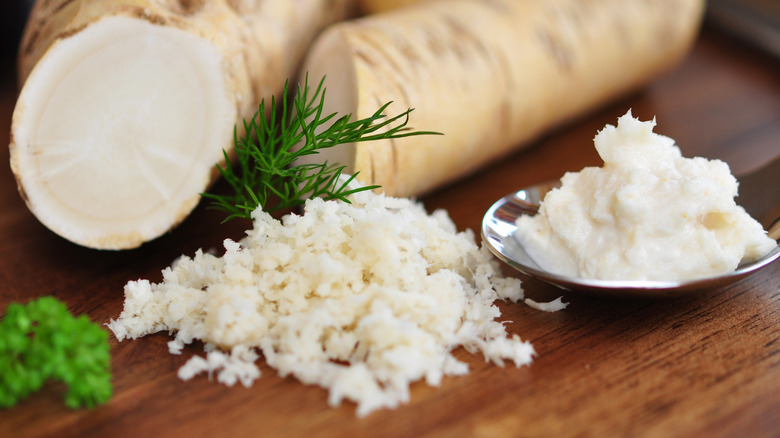What Is Horseradish And What Actually Makes It Hot?
Horseradish is a tricky ingredient that can be delicious in moderation but overbearing if you use even a bit too much. Paired with ketchup, it becomes a tasty cocktail sauce, but it also blends well in aioli, where it can be placed atop a steak sandwich for the perfect hint of heat.
This peculiar food has been used in cooking for ages, but you have to be particular about how you use it. Much like wasabi and mustard, you'll quickly understand its bracing flaws if you consume too much in one bite.
Horseradish is derived from the flowering horseradish plant, and if you're just now making the flavor connection that it does taste like wasabi or mustard, that's because all three are actually related — they're in the same plant family (Brassicaceae). As far as where that spicy flavor comes from, it's actually a chemical process that mimics tear gas and pepper spray. When the root of the horseradish plant is ground up, certain oils are activated, which then unleash that aggressive spice. Horseradish's flavor is actually meant to act as a defense mechanism for the plant, but we know it as a great addition to sauces and other dishes.
What makes horseradish so hot?
Horseradish's heat doesn't come with the same spice we think of when we eat hot sauce or chili peppers. It's a nose-curdling spice that, when overindulged in, could make even the stuffiest sinuses instantly clear up. This plant root, which loves the sunshine, is turned into a condiment by first being grated, then added to a jar with other elements, such as vinegar and salt, to turn it into more of a spread. When grated, horseradish releases a chemical known as allyl isothiocyanate, which is what causes our reaction to it. It has to be stored quickly after being ground because if exposed to air, the oils that are expressed only have a short life before the shredded root loses its flavor. Still, freshly grated horseradish root can be used on its own and added to dishes.
Horseradish gets its spice from that chemical element, which lives within the root, but the plant didn't evolve for human consumption. Rather, horseradish's overpowering flavor was designed to keep bugs away; it's a form of protecting itself. However, since bugs are also animals, they happen to share the same receptors that we do, so if horseradish isn't used sparingly, we react the same way.
Why do we eat horseradish?
If our body responds to it like tear gas, then what makes this plant root so appealing? Like plenty of herbs and plants, horseradish started out being used for medicinal purposes, including treating inflammation and back pain. It remains a bit unclear how exactly it transitioned from a medicine to a condiment, but it was popularized in Central Europe sometime after the 1400s and, when used in moderation, adds a pleasant element of spice to a dish.
Cocktail sauce gets much of its flavor from horseradish, but when paired with ketchup, it's muted enough to be enjoyed for its spice without giving the body a reaction. Because its unique spice hits the taste buds a bit differently than traditional peppers, as a result, it's become a popular addition on sandwiches, in dips, and even in cocktails like the bloody mary. Of course, during the Passover holiday, it's eaten with gefilte fish.
It's best to add horseradish cautiously to start, then increase as desired. You could start with some of Arby's signature Horsey Sauce on a roast beef sandwich, then move on to making your own horseradish mashed potatoes. Just taste as you go and you'll be fine.


